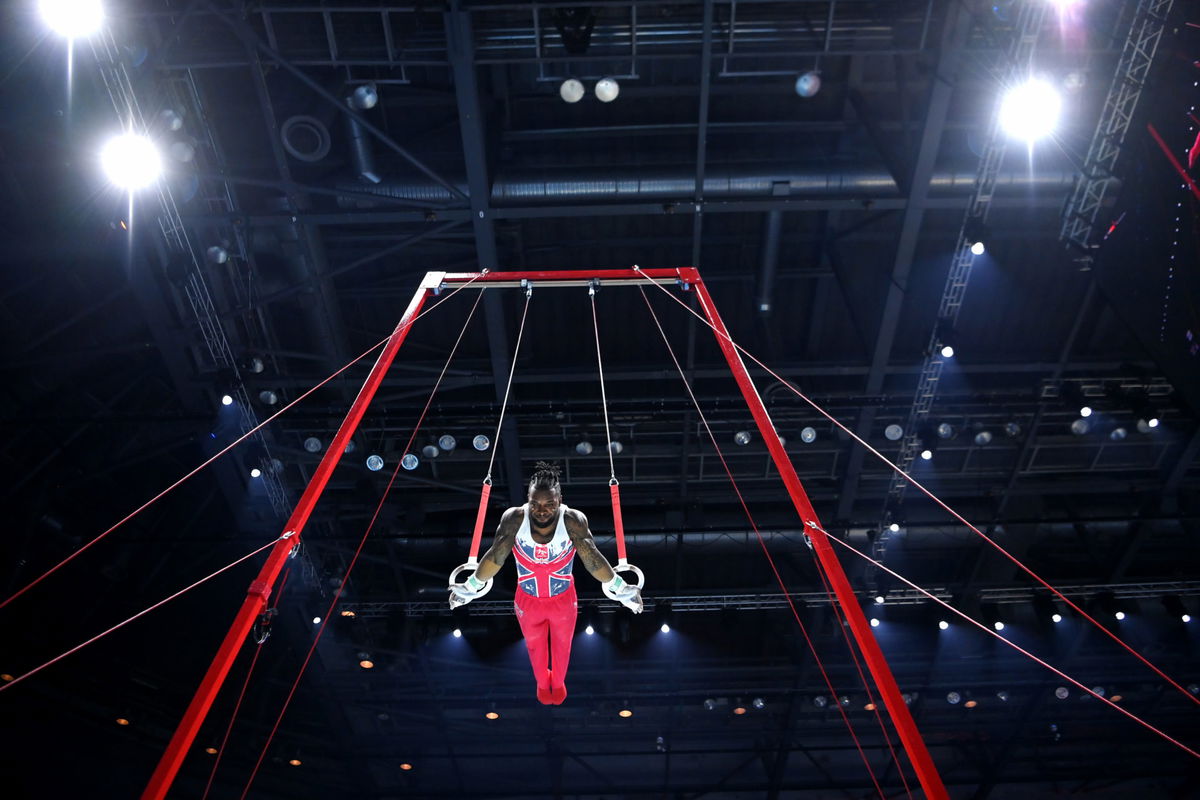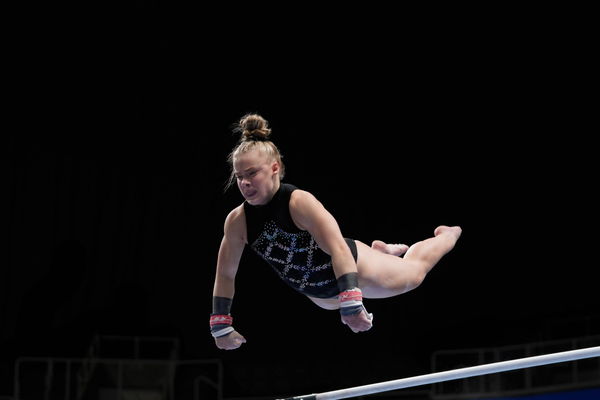
Getty
LIVERPOOL, ENGLAND – OCTOBER 31: Courtney Tulloch of Team Great Britain competes on Rings during Men’s Qualifications on Day Three of the FIG Artistic Gymnastics World Championships at M&S Bank Arena on October 31, 2022 in Liverpool, England. (Photo by Laurence Griffiths/Getty Images)

Getty
LIVERPOOL, ENGLAND – OCTOBER 31: Courtney Tulloch of Team Great Britain competes on Rings during Men’s Qualifications on Day Three of the FIG Artistic Gymnastics World Championships at M&S Bank Arena on October 31, 2022 in Liverpool, England. (Photo by Laurence Griffiths/Getty Images)
The preparations for the 2023 World Artistic Gymnastics Championships are in full swing in Antwerp. This beautiful Belgian city, specifically its Sportpaleis arena, will play host to the biggest names in the gymnastic world from September 30 onwards. The fans cannot wait for the championships to commence and witness the incredible displays of strength and grace from gymnasts around the globe.
Watch What’s Trending Now!
The excitement has gone through the roof since Simone Biles‘ made a staunch comeback. The seven-time Olympic gymnastics medallist began her journey ten years ago with a debut in Antwerp. Now she returns to the city where it all began and has some secret moves up her sleeve.
The gymnastics G.O.A.T has drawn a lot of new fans to the sport with her fabled Yurchenko double pike. While most gymnastic enthusiasts watching her and her fellow gymnasts are awestruck by their moves, often, the viewers don’t understand the gymnastic terms used during the telecast. So, let’s take a panoramic view to understand the technical aspects of the terms, abbreviations, and symbols used during the championships.
ADVERTISEMENT
Common gymnastics terms
Like most other sports, gymnastics also has its own terminology. There are many terms in gymnastics that make it hard for even longtime fans to remember them all. The list given below of the terms will refresh the fan’s memories and also instruct them about some new coinages.
| ?????????? Term | ??????? Definition | ????? Abbreviation | ?????????? AKA |
| Yurchenko | It is a vaulting technique where the athlete performs a round-off on their hands on the springboard and finishes with a backflip on the vaulting table. | N/A | N/A |
| Tsukahara | A vaulting style where instead of the springboard, the vaulting table is used as a means for a handspring followed by a half turn and a backflip finish. | N/A | Tsuk |
| full-in | It is a marvelous move performed on the mat that involves a full twisting double tuck and a back somersault at the end. | N/A | N/A |
| piked full-in | It is also a full twisting move, but it adds a double pike back somersault. | N/A | N/A |
| double double | As the name suggests, the move comprises a double twist and a double tuck with a final back somersault. | N/A | N/A |
| triple double | Instead of the double twist from the double double, this one has three twists, and the rest stays the same. | N/A | Biles 2 |
| 1/1 | Full twist. | N/A | N/A |
| 3/2 | One full twist and a half. | N/A | N/A |
| 2/1 | Double twist | N/A | Double full |
| 5/2 | Two full twists and a half one at the end. | N/A | N/A |
| 3/1 | Triple twist | N/A | Triple full |
| 7/2 | Three full twists and a half one at the end. | N/A | N/A |
| CI | It is a competition scenario where just the team competitions are taking place. | N/A | N/A |
| CII | It is a competition only for the all-around gymnasts. | N/A | N/A |
| CIII | As per the rules, this sort of competition only allows individual event finals. | N/A | N/A |
ADVERTISEMENT
Abbreviations that you need to know
The artistic gymnastics rulebook is full of abbreviations. This article will inform you of these abbreviations and classify them into five different categories.
ADVERTISEMENT

ADVERTISEMENT
- Disciplines
ACR ? Sports Acrobatics
Top Stories
Cowboys Fire Defensive Coordinator Matt Eberflus: Contract, Salary, NFL Earnings & More

Adam Peaty Faces Gordon Ramsay’s Sly Dig Amid Parents’ Controversial Wedding Absence

Russell Wilson Announces Retirement Stance as Giants QB Shares Hidden Injury News

Marina Mabrey Is Raising Eyebrows Again With Fiery Unrivaled Confrontation

Huge Fire Destroys Over 125-Year-Old Golf Club Designed by 5x Open Winner in London – Report

Dolphins Reportedly Indecisive About Mike McDaniel as GM Search Kicks Off

AER ? Sports Aerobics
ADVERTISEMENT
DMT ? Double Mini Trampoline
GFA ? Gymnastics for All
JO ? Junior Olympic
ADVERTISEMENT
MAG ? Mens Artistic Gymnastics
PRK ? Parkour
RG ? Rhythmic Gymnastics
ADVERTISEMENT
T&T ? Tumbling and Trampoline
TRA ? Trampoline
TUM ? Tumbling
ADVERTISEMENT
WAG ? Women’s Artistic Gymnastics
- Governing Bodies
AAU ? American Athletic Union
BG ? British Gymnastics
EG ? European Gymnastics
FIG ? F?d?ration Internationale de Gymnastique
GA ? Gymnastics Australia
GC ? Gymnastics Canada
NCAA ? National Collegiate Athletic Association
USAG ? USA Gymnastics
- Apparatus
AB ? Asymmetric Bars
BB ? Balance Beam
FX ? Floor Exercise
HB ? High Bars
PB ? Parallel Bars
PH ? Pommel Horse
SR ? Still Rings
UB ? Uneven Bars (the same apparatus as Asymmetric Bars)
VT ? Vault
- Competition Scoring
AA ? All-Around
CoP ? Code of Points
CV ? Connection Value
DD ? Difficulty Score
EF ? Event Final
EGR ? Element Group Requirement
EX ? Execution Score
OOB ? Out of Bounds
SB ? Series Bonus
SV ? Start Value
TF ? Team Final
- Common Moves
BHS ? Back Handspring
BW ? Back Walkover
CW ? Cartwheel
DLO ? Double Layout
DTY ? Double Twisting Yurchenko
FF ? Flic Flac (another name for BHS)
FR ? Forward Roll
FTY ? Full Twisting Yurchenko
FHS ? Front Handspring
HS ? Handstand
LO ? Layout
LOSO ? Layout Step Out
PK ? Pike
RO ? Round Off
TTY ? Triple Twisting Yurchenko
TU ? Tuck
All the symbols related to gymnastics
With the knowledge of these abbreviations, even newbies can follow the World Artistic Gymnastics Championships without any confusion. However, there are certain symbols used in the gymnastics competition that most people cannot decipher.
These symbols often pertain to the result of an event, so it is crucial for everyone to know about them.

These are some of the most common symbols and their associated meanings.
G1– G1 pertains to Group 1, which you will find only in the World Championships and the Olympics.
B4– This is an archaic term from the time of the Cold War. It was used to denote the Big Four gymnastics competitions, namely the World Championships, the Olympics, the European Championships, and the World Cup.
C– The other major gymnastic events, such as the Asian Games, European Championships,? and Pan-American Games, are referred to as C, which stands for Continental Championships.
D– This denotes domestic championships like the U.S. Classic. It may also appear during international competitions besides the names of the athletes performing on their home turf.
J– It refers to the junior circuit where the rising talents are developing.
X– This means nothing, and the competitions that don’t fit the criteria mentioned above use this symbol.
Watch this story:?Months After Simone Biles and Jonathan Owen?s Wedding, the Olympic Gymnast Reveals the Biggest Fight With Her NFL Husband
ADVERTISEMENT
ADVERTISEMENT
ADVERTISEMENT

